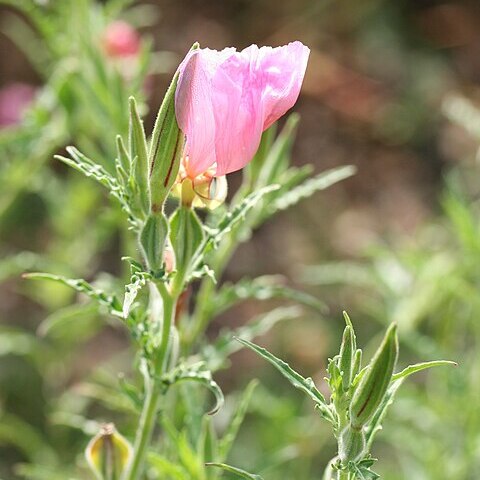Perennial herb, sometimes suffrutescent, decumbent to ascending, with few simple or branched stems 1.5-5 dm. long, more or less strigulose and also with long spreading hairs; basal leaves oblanceolate or broader, 3-10 cm. long, 1-3 cm. wide, sinuate-pinnatifid, with several ovate-oblong lateral lobes and a larger terminal one, subglabrous to villous, with well developed petioles; cauline leaves reduced, 2-5 cm. long, mostly sinuate-pinnatifid; flowers vespertine, in axils of uppermost reduced leaves; floral tube commonly hirsute as well as strigose, ca. 1 cm. long, puberulent within at base; sepals commonly reddish, 2-3.5 cm. long, coherent in anthesis, at least in pairs, with minute free tips in bud; petals white, rose in age, 2-3.5 cm. long, broadly obovate; stamens subequal, one-half to two-thirds the length of the petals; filaments 1-1.5 cm. long; capsule proper obovoid, 1-1.5 cm. long, 0.6-0.8 cm. thick, hirsute, especially on veins and wings, the latter 2-3 mm. wide, capsule narrowed into a basal ribbed hollow sterile part 0.5-2.5 cm. long; seed light brown, obovoid, ca. 1.3 mm. long.
Perennial herb, often flowering the first year, with numerous stems commonly 15-40 cm. tall from a somewhat woody caudex. Plants covered with long spreading hairs throughout, and also with shorter appressed hairs. Leaves 3-10 cm. long, oblanceolate or elliptical, the basal ones usually sinuate-pinnatifid, the cauline ones irregularly sinuate-pinnatifid in outline to entire, much reduced in size; petioles mostly less than 1 cm. long. Inflorescence erect, the flowers in the axils of much reduced leaves. Flowers opening near sunset. Floral tube 8-10 mm long. Sepals 2-3 cm. long, usually coherent and deflexed to one side in anthesis. Petals 2.5-3.5 cm. long or as short as 1-4 cm. late in the season, white, fading purplish, broadly obovate. Anthers 5-6 mm long, the filaments 1-1.5 cm. long. Style held above the anthers at anthesis; stigma with linear lobes 4-8 mm long. Capsule clavate, 10-15 x 6-8 mm, with prominent wings 2-3 mm wide, the base gradually narrowed into a hollow, ribbed stipe 5-25 mm long. Seeds c. 1-3 mm long, light brown, obovoid, in 2 rows in each locule.
Weedy perennial, 0.15-0.40 m high; many stems from a woody caudex; long-spreading hairs throughout. Leaves alternate, ± oblanceolate, entire to irregularly sinuate-pinnatifid, base cuneate, apex acute; petioles up to 10 mm long. Flowers borne in axils of reduced leaves, opening near sunset, nocturnal. Floral tube up to 10 mm long. Sepals deflexed to one side in anthesis. Petals up to 35 mm long, white, fading purplish. Flowering time Oct.-Jan. Fruit a capsule, up to 15 x 8 mm, with prominent wings, base gradually narrowed into hollow, ribbed stipe. Seeds obovoid.
Perennial herb, sometimes woody at base, 15–50 cm high. Stems simple or branched, usually bearing long spreading and short appressed hairs. Basal leaves rosetted, oblanceolate, to c. 10 cm long, sinuate or lobed; cauline leaves ovate-lanceolate to oblanceolate, much shorter, broader, acuminate, usually irregularly lobed. Flowers solitary. Hypanthium c. 1–3 cm long. Sepals 2–4 cm long. Petals 2–3.5 cm long, white turning pink with age. Capsule broadly clavate, 0.5–2.5 cm long, with wings 2–3 mm wide on upper part and a tapered base, hirsute.
Perennial herb, 0.15-0.40 m high; covered with long spreading and shorter appressed hairs. Leaves petiolate; blade narrowly obovate or elliptic, 30-100 mm long, margins irregularly sinuate-pinnatifid to entire; petioles < 10 mm long. Flowers: up to 60 mm in diameter; floral tube 8-10 mm long; sepals 20-30 mm long; petals 20-30 mm long, white, fading purplish; Sep.-Apr. Fruit clavate, 10-15 mm long.
A herb. It grows 15-50 cm tall. It can form clumps. The leaves are narrowly oval and 3-10 cm long by 1-3 cm wide. Flowers open near sunset. They are white.
Hirsute perennial herb, 150-400 mm tall. Capsule clavate. Flowers opening near sunset; up to 60 mm in diameter; white, fading purplish.

